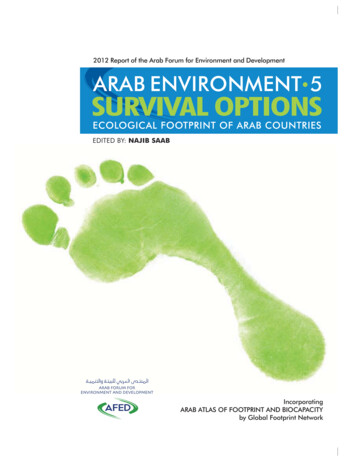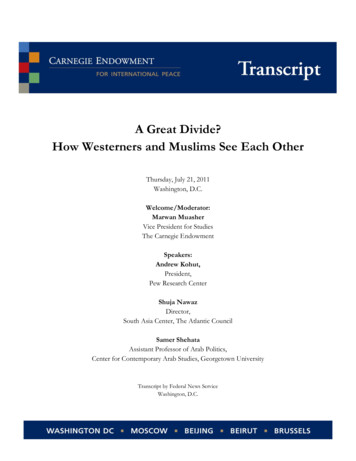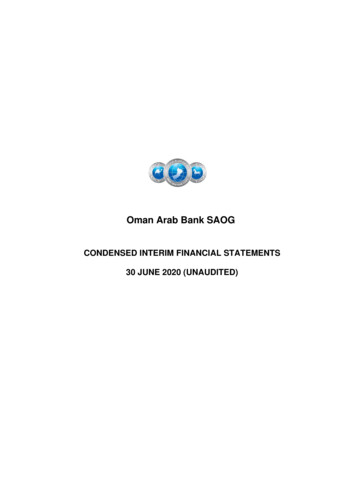
Transcription
Working with Arab American Clients:A culturally relevant, sensitive, andcompetent approachHazem HajajThis training is provided to San MateoCountyBehavioral Health and Recovery ServicesJanuary 21, 2015
Objectives Develop a better understanding of the Arab American population. Examine the expectations and perceptions Arab American clientshave of their mental health providers. Learn culturally sensitive strategies for working with Arab Americanclients; gain confidence in using these strategies in practice.16-2
ARABWhen you hear the word Arabwhat comes to mind?16-3
Where are Arab’s from?16-4
Arab DefinedAn Arab identifies as being from one of the following 22 Arab countries that stretchfrom North Africa to the Arabian Gulf. Iran and Turkey are not Arab countries.16-5
Arab Societies Arabs are ethnically, religiously and politically diverse but descend from acommon linguistic and cultural heritage. Despite the variations in dialectsand accents across the region all Arab countries understand classicalArabic which is spoken formally in print and news etc. To be an Arab, like an American, is a cultural trait rather than racial. Arab Americans began arriving to the United States during the late 19thcentury and early 20th century.16-6
Arab Societies Cont. Today there are over 3.5 million Arab Americans in the U.S. Mostrecently Arabs have immigrated to the U.S. in response to traumaticevents such as war.The cities with the largest Arab American populations are Los Angeles,Detroit, New York, Chicago and Washington, D.C.In California Arabs are reported at about 715,000 with the largestdemographic being Lebanese, Syrian and Palestinian. Numbers aredifficult to come by since the American census does not have a box forArab.16-7
Acculturation Acculturation is the process of adapting to a new culture– May involve learning the dominant language, adopting new valuesand behaviors It appears that length of residence, distribution, and intermarriage allhave a positive correlation with acculturation, while distinguishingphysical characteristics, cultural and religious differences, anddiscrimination have a negative correlation with acculturation16-8
Acculturation Cont. There has been little research conducted on the acculturation ofimmigrants from Arabic-speaking countries. Surprising since Arabimmigrants have been coming to the United States since at least 1854,and they number over three million today Studies suggest that Arabs find acculturation to be more difficult thanmany other immigrant groups– Especially true for those who are Muslim16-9
Acculturation Cont. Feel as though they are viewed more as Arabs, and less as AmericansDiscrimination seems to be the most important factor affecting theacculturation of Arab-Americans. EthnicArab immigrants to Western countries are known to experience dividedloyalties between the ways of the new country and those of the old andthe dilemma "of whether to reject or embrace assimilation, secularism,and Western education"Ex. Yemeni Community OaklandA researcher once describe some ethnic Arab communities in the Westas "a nation in exile rather than as immigrants16-10
Arab ValuesArab Culture Values Collective Interdependence of family Family decision making Relationships Tradition Fate is my master EducationWestern Values Individualistic Independence / Self-reliant Autonomous decision-making Possessions Technology Master of my fate Experience16-11
Cultural Norms GreetingTouchDignity and honor everything one does reflects on family honor of past,present, and future generationsReputation is criticalPersonal spaceEye contactRespect (elderly)Implications for nursing homes & elder care16-12
Religion Common Misconceptions: Not all Arabs are Muslim. Not all Muslims areArab. The Arab American community is religiously diverse. Almost every majorreligion is represented in the Arab American community. Christians: Maronite Catholic, Melkite Catholic, Syrian Catholic,Chaldean Catholic, Roman Catholic, Antiochian Orthodox, SyrianOrthodox, Coptic Orthodox, Protestant Muslims: Sunni, Shia and Druze16-13
Cultural Competence is a Journey,Not a Destination.Cultural competence does not mean endorsing another’s beliefs, butsimply making room in your world for that person to hold their beliefs. Agood way to think about cultural competency is through practicingCultural humility.Cultural humility is the “ability to maintain an interpersonal stance thatis other-oriented (or open to the other) in relation to aspects of culturalidentity that are most important to the [person]. Which is a life longprocess that individuals consciously enter into with clients, colleagues,friends and themselves.16-14
Mental Health Services andStigmatization Mental health services can be stigmatizing, particularly for women. Arab clients, like those in other non-Western societies, find psychiatricand psychological intervention stigmatizing. For women, the stigma of mental health services could damage theirmarital prospects, increase the likelihood of separation or divorce. Clients of ethnic Arab origin have a negative view of mental healthservices and may tend to mistrust and underuse them. Arab peoples, particularly in Arab countries, do not distinguish amongpsychiatrists, psychologists, or other professionals in the mental healthfield. Taboo Topics Depression/Posttraumatic Stress Disorder, Abuse (sexual,physical, emotional)16-15
Role of Family in Interventions Family is important within Arab communities. They are expected to be involved and are consulted in times of crisis. The family's involvement in individual life often makes the work morecomplicated. Arabs value and guard privacy but their personal privacy within the familyis virtually non-existent. Decisions regarding health care are made by the family group and arenot the responsibility of the individual alone. In some cases the family will intervene on behalf of the identified clients16-16
Role of Religion in Interventions Consideration must be given to the role religion may play in helping theintervention process when working with some Arab-Americans. Acceptance Gods Will: Inshallah I3kal wa Tawakel16-17
Practical recommendations for clinicians working withArab-Americans: Attitudes Flexibility, open-mindedness, and non-judgment Awareness of own biases, worldview and privileges Respect for cultural and religious differences Openness to other worldviews and ways of being Awareness that collectivist cultures often address problems in different ways Awareness that internalizing disorders can be more common in collectivistoriented family systems Awareness that ethnic identity is an important part of personal identity Attitude of flexibility and curiosity16-18
Practical recommendations for clinicians working withArab-Americans: Knowledge Knowledge of ethnic, religious, socioeconomic, political diversity withinArab-American communities Understand the absence of mainstream dialogue about mental healthissues in Arab-American communities Lack of spectrum of mental health issues in Arab awareness; patientsand their families may not see gray area between sane and “crazy” Mental illness and psychological distress carrying indicant stigma andsame in Arab culture It is uncommon to discuss problems with nonfamily members Symptoms are often minimized to protect family or because it isculturally inappropriate to complain16-19
Practical recommendations for clinicians working withArab-Americans: Knowledge Cont. Grieving in Arab cultures is qualitatively different from majority U.S.culture Arab people may expect to be judged negatively by the therapist Knowledge about immigrant experiences is important Trauma symptoms may be minimized in Arab cultures Arab American clients may have low expectations of the efficacy ofpsychotherapy Family dynamics are different in Arab cultures Gender: Same gender clinician preferred16-20
Practical recommendations for clinicians working withArab-Americans: Skills Assess for acculturation, socioeconomic status, and ethnic identitydevelopment Explore expectations of therapy Do not assume that all patients had a typical American childhood Assess for internalizing disorders and expect minimization of symptoms Assess for trauma symptoms. Offer psych education on typical traumasymptoms and effects Explore uncertainty about attending psychotherapy and clearly explainprocess Focus upon therapeutic alliance before engaging specific therapeuticinterventions; get to know person’s history, family system, and ethnicidentity before focusing upon presenting problem16-21
TedTalk“The single story creates stereotypes, and the problem with stereotypes isnot that they are untrue, but that they are incomplete. They make one storybecome the only story.”Link : http://www.ted.com/talks/maz jobrani make jokes not bombsLink : http://www.ted.com/talks/chimamanda adichie the danger of a single story16-22
Remember Be respectful Non-judgmental Ask how YOU can make THEIR experience more comfortable andcongruent with their culture and religion Just because a person identifies as a member of an ethnic, religious ordemographic community DOES NOT mean they value the entire culturalperspective. APOLOGIZE for cultural mistakes Ask Questions16-23
Resources Google.com Haboush, K. L. (2007), Working with Arab American families: Culturallycompetent practice for school psychologists. Journal of Cultural Diversity- The cultural gap delivering health careservices to Arab American populations in the United States. ACCESS Guide to Arab Culture: Health Care Delivery to the ArabAmerican Community- Adnan Hammad, Ph.D Arab Cultural Center : www.arabculturalcenter.org/ Arab American Institute: http://www.aaiusa.org16-24
Arab immigrants to Western countries are known to experience divided loyalties between the ways of the new country and those of the old and the dilemma "of whether to reject or embrace assimilation, secularism, and Western education" Ex. Yemeni Community Oakland A researcher once describe some ethnic Arab communities in the West









